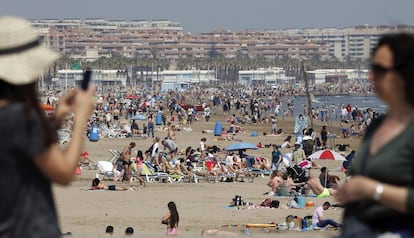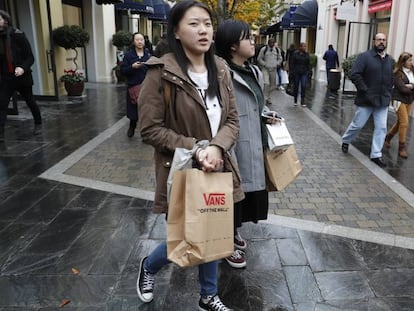Record-breaking Easter boosts hopes for summer tourism bonanza in Spain
Public Works Ministry says hotel occupancy rates up 10% on 2016 figures, aided by good weather
Spain has shattered even the most optimistic forecasts for tourist arrivals during the Easter break that just ended. The good weather encouraged last-minute planners to make the most of the vacation time that ended on Sunday or Monday, depending on the region. Industry sources confirmed high occupancy rates not just at the usual coastal destinations, but also in cities and in rural enclaves. “Frankly, things could not have gone better,” said Public Works Minister Íñigo de la Serna.

According to the minister, occupancy rates were 10% higher compared to the same period last year. “Our economy keeps growing, and this new push makes us optimistic about growth forecasts for the Spanish economy,” said De la Serna at a public event organized by the business newspaper El Economista.
A record 75 million foreign visitors came to Spain last year, and the tourism industry is hoping to set a new high this year, based on the positive Easter figures.
We’re coming off the back of three very good years. We’re on a roll
Joseba Cortázar, Toprural
Average hotel occupancy rates were between 85% and 90% in inland destinations, and 90% on the coast, according to numbers released by the industry group CEHAT. The island of Tenerife had an occupancy rate of 92% while Lanzarote had 90%. Along the Costa del Sol, the average occupancy rate was 83.57%, while the small northern region of Cantabria reached 100% on Maundy Thursday and Good Friday.
In the Catalan province of Lleida, the occupancy rate was 95%, said the regional tourism board in a release. Around 80,000 tourists visited the province between April 8 and 17.
Rural getaways
Meanwhile, rural lodgings have enjoyed a spike thanks to increased tourism by Spaniards following the rebound of the economy. This type of tourism depends to a great extent on national visitors, who make up 75% of annual overnight stays, said Joseba Cortázar, the communications director for Toprural, a leading website for rural accommodation bookings.
“We’re coming off the back of three very good years. We’re on a roll,” said Cortázar, who says that on a normal weekend the average occupancy rate is 30%. “On Wednesday, we already had enough bookings to represent 85%. Easter is to rural tourism like summer: high season.”
The challenge now, says Cortázar, is to get visitors coming throughout the rest of the year, and raising rates again. “Prices went down and services were added in order to get through the crisis. And they have not recovered at the same rate as hotels,” says Cortázar.
Tourist apartments
Tourist apartments are also surging as an alternative option, especially on the coast. Besides those which are run by professional agencies, growing numbers of private owners are offering accommodation on websites such as Airbnb despite a growing confrontation with city authorities in places like Madrid or Barcelona, who say the practice is pushing up the rent for local residents and forcing them out of their neighborhoods. And Palma de Mallorca recently announced plans to ban tourist apartments altogether by the summer.
English version by Susana Urra.









































